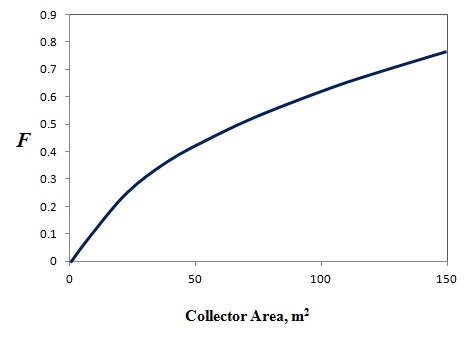The method called f-Chart is one of the empirical frameworks that uses standardized metrics to characterize the long-term performance of solar heating systems. It was originally developed by Klein, Beckman, and Duffie in 1976. Although it has some uncertainties and is mostly applied to standard designs, it provides a quick and robust estimate of system performance using collector parameters and average monthly radiation and temperature data. To this end, understanding the f-Chart data can be useful.
The f value, which is a targeted output in f-Chart computations, characterizes the fraction of a total heating load supplied by solar energy:
\[f = \frac{{{\rm{solar_-energy_-input_-to_-load}}}}{{{\rm{total_-energy_-load}}}} = \frac{{{L_s}}}{{{L_s} + {L_a}}}\]
To set up the calculation you need to choose and specify the following variables: collector area, collector type, storage capacity, fluid flow rates, heat exchanger sizes. Those parameters can be set at the design stage and can be adjusted further to achieve a desirable outcome.
The f-Chart model correlates those parameters with thermal performance. This correlation is empirical and is the result of treatment of hundreds of simulations and case studies of solar heating systems. In the end, f is presented as a function of two dimensionless parameters X and Y:
\[X = \frac{{{\rm{collector_-energy_-losses}}}}{{{\rm{total_-heating_-load}}}}\]
\[Y = \frac{{{\rm{total_-energy_-absorbed_-by_-collector}}}}{{{\rm{total_-heating_-load}}}}\]
These metrics are normally defined for a one-month period. In terms of collector properties, these values can also be expressed as follows:


All the parameters and properties used in these metrics are available from collector tests and conditions chosen, so they should be quite straightforward to calculate. Let us define all the properties included (D&B, 2013):
Ac = collector area (m2)
F'R = collector heat exchanger efficiency factor
Δt = total number of seconds in month
Ta = monthly average ambient temperature (oC)
Tref = empirical reference temperature (100 oC)
L = monthly total heating load for space heating and hot water (J)
HT = monthly average daily radiation incident on collector (J/m2)
N = number days in month
(τα) = monthly average transmittance-absorptance product
The products FR(τα) and FRUL are determined from standard collector tests. The example calculations of X and Y values for a typical solar heating system are given in Example 20.2.1 of the D&B textbook. Further, X and Y are used to calculate f - the monthly fraction of the load supplied by the solar energy. For tha purpose, the following empirical equations are used:
For liquid systems:
\[f = 1.029Y - 0.065X - 0.245{Y^2} + 0.0018{X^2} + 0.0215{Y^3}\]
For air systems:
\[f = 1.040Y - 0.065X - 0.159{Y^2} + 0.00187{X^2} - 0.095{Y^3}\]
Note: these equations are the result of model data fitting (so do not try to justify it by any theoretical derivations). They are simply used as the approximations of model results fitted to the pair of X and Y values.
Further, the total solar fraction of annual load (F) can be found by the sum of all monthly fractions:
\[F = \frac{{\sum {{f_i}{L_i}} }}{{\sum {{L_i}} }}\]
For example, for a liquid-based heating system, if we perform this calculation for different collector areas, we observe an increase of solar energy fraction as the system gets larger (Figure below). Based on this output, we can select the collector area for the project to cover the desired amount of energy needs.

Figure 7.1: Annual solar energy fraction in total load as a function of collector area of a solar heating system determined by f-Chart method.
The chart above is only one representation of f-Chart performance data. A number of other properties can be presented in similar diagrams. Please refer to the following reading to learn more details about the f-Chart method and to see more examples and illustrations of how it is applied.
Reading Assignment
Examples in Sections 20.2-20.4 are especially useful.
The f-Chart method can be applied to the following systems (Haberl and Cho, 2004):
- Water storage heating
- Pebble bed storage heating
- Building storage heating
- Domestic water heating
- Integral collector-ctorage DHW
- Indoor and outdoor pool heating
- Passive direct gain
- Passive collector-storage wall
The following types of solar collectors can be included in this treatment:
- Flat plate
- Evacuated tube
- Compound parabolic concentrating
- 1-axis and 2-axis tracking
To summarize: the f-Chart method is an express tool for thermal design assessment. It allows quick estimation of solar heating system performance, although errors up to 5-10% may be present due to approximations. That is the price of speed and convenience. The uncertainties may be due to variations in meteorological data, averaging performance data, system use and occupants' behavior, and individual system flaws and imperfections.
This method is especially recommended for exploring relative effects of design changes and also as a benchmark for comparison with real-life performance data from a system.
While the calculations described above can be made by hand, there is licensed software (FCHART) available (but not free) via www.fchart.com (2005).
References:
Duffie, J.A. Beckman, W., Solar Engineering of Thermal Processes, John WIley & Sons, 2013.
Haberl, J.S. and Cho, S., Literature Review of Uncertainty of Analysis Methods (F-Chart Program), Report to the Texas Commission on Environmental Quality, Energy Systems Laboratory, Texas A&M Univeristy, ESL-TR-04/08-04, August 2004.
Klein, S.A., Beckman, W.A., and Duffie, J.A. A Design Procedure For Solar Heating Systems, Solar energy 18, 113- 126 (1976).
